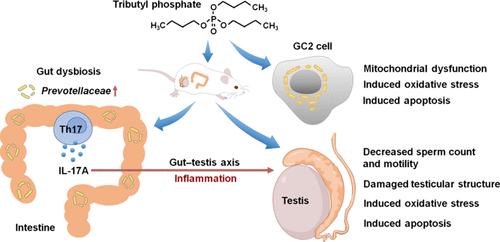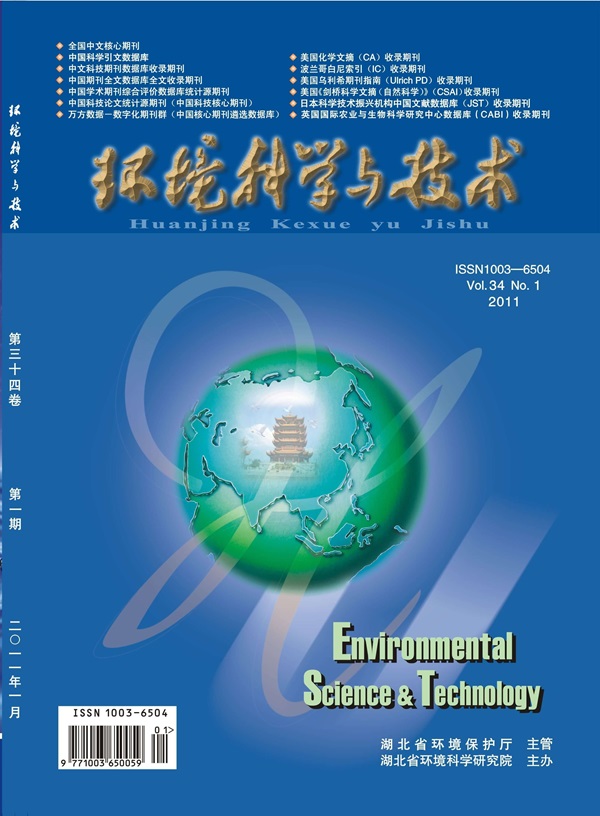IF 10.8
1区 环境科学与生态学
Q1 ENGINEERING, ENVIRONMENTAL
引用次数: 0
摘要
磷酸三丁酯(TBP)是一种新出现的有害物质,在环境中无处不在。然而,TBP 是否会影响男性生殖系统仍是未知数。在本研究中,我们将雄性 ICR 小鼠和小鼠精母细胞 GC-2 暴露于 TBP,以探讨 TBP 对雄性生殖系统的毒性。结果显示,小鼠口服 TBP(50 和 100 毫克-千克-1-天-1)35 天后,精子数量和活力下降,睾丸结构受损,并诱导细胞凋亡。暴露 24 小时后,TBP(10、50 和 200 μM)可抑制细胞活力,诱导细胞凋亡,并降低 GC-2 细胞中 BCL2/BAX 的比率。TBP(50 和 200 μM)会引发活性氧的积累,并诱导 GC-2 细胞线粒体膜电位的降低。此外,TBP 还导致肠道微生物群失调和新陈代谢谱改变,并增加了与精子活力负相关的前鞭毛菌科(Prevotellaceae)的丰度。此外,TBP 还会引起炎症,诱导 Th17 细胞渗入小鼠小肠,并刺激小鼠睾丸的 IL-17A 信号传导。总之,TBP 通过肠道-睾丸轴、氧化应激和细胞凋亡诱导雄性生殖毒性,为 TBP 对雄性哺乳动物的生殖危害提供了新的视角。本文章由计算机程序翻译,如有差异,请以英文原文为准。

Tributyl Phosphate Induced Male Reproductive Toxicity in Mice
Tributyl phosphate (TBP) is an emerging hazardous material that is ubiquitous in the environment. However, whether TBP affects the male reproductive system remains unknown. In this study, we exposed male ICR mice and mouse spermatocyte GC-2 cells to TBP to explore the male reproductive toxicity of TBP. The results revealed that TBP (50 and 100 mg·kg–1·day–1) decreased sperm count and motility, damaged testicular structure, and induced apoptosis in mice after 35 days of oral gavage. TBP (10, 50, and 200 μM) inhibited cell viability, induced apoptosis, and reduced the ratio of BCL2/BAX in GC-2 cells after 24 h of exposure. TBP (50 and 200 μM) triggered the buildup of reactive oxygen species and induced a reduction in the mitochondrial membrane potential within GC-2 cells. In addition, TBP led to gut microbiota dysbiosis and metabolic profile alterations and increased the abundance of Prevotellaceae, which are negatively associated with sperm motility. Furthermore, TBP caused inflammation, induced the infiltration of Th17 cells into the mouse small intestine, and stimulated IL-17A signaling in mouse testes. In conclusion, TBP induced male reproductive toxicity via the gut–testis axis, oxidative stress, and apoptosis, offering fresh perspectives on TBP’s reproductive hazards in male mammals.
求助全文
通过发布文献求助,成功后即可免费获取论文全文。
去求助
来源期刊

环境科学与技术
环境科学-工程:环境
CiteScore
17.50
自引率
9.60%
发文量
12359
审稿时长
2.8 months
期刊介绍:
Environmental Science & Technology (ES&T) is a co-sponsored academic and technical magazine by the Hubei Provincial Environmental Protection Bureau and the Hubei Provincial Academy of Environmental Sciences.
Environmental Science & Technology (ES&T) holds the status of Chinese core journals, scientific papers source journals of China, Chinese Science Citation Database source journals, and Chinese Academic Journal Comprehensive Evaluation Database source journals. This publication focuses on the academic field of environmental protection, featuring articles related to environmental protection and technical advancements.
 求助内容:
求助内容: 应助结果提醒方式:
应助结果提醒方式:


